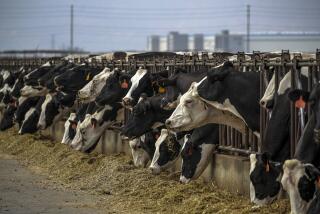Officials study valley fever outbreak at solar power projects
- Share via
Epidemiologists are investigating an outbreak of valley fever that has sickened 28 workers at two large solar power construction sites in San Luis Obispo County.
Staff from the California Department of Public Health, and investigators from the California Division of Occupational Safety and Health and San Luis Obispo County visited the sites near the Carrizo Plain two months ago, officials said.
They identified the sites as the Topaz Solar Farm and California Valley Solar Ranch, two large-scale photovoltaic power plants whose construction often requires considerable scraping and clearing to make way for thousands of acres of solar panels.
Valley fever, also known as Coccidioidomycosis, is contracted by breathing in fungal spores released when desert soils are disturbed. The illness is prevalent in many areas of the California desert and is common among agricultural workers and construction crews. It is not contagious.
Of those who contract the illness, less than half develop flu-like symptoms that include a cough, fever, chest pains and muscle aches that can persist for weeks. In extreme cases, valley fever can cause death, usually among patients with compromised immune systems.
State officials did not provide details about who contracted the illness at the solar sites, or where they live, citing medical privacy laws. But at least one case involves an electrical worker at the California Valley project.
Mark Simonin, business manager for the International Brotherhood of Electrical Workers, Local 639 in San Luis Obispo, said the electrician was digging into the ground with a claw hammer and inhaled dust. Simonin said the man became ill and a subsequent blood test confirmed valley fever.
The worker required breathing therapy treatment but didn’t miss any time off the job, Simonin said.
Although respirators can prevent valley fever, workers laboring in harsh desert heat find the large commercial masks uncomfortable and are reluctant to wear them, Simonin said. He said the developer has done good job keeping dust down on the site.
The threat of acquiring the respiratory illness extends to residents living near expansive construction sites. That risk is rising given the scope of the renewable energy boom centered in the state. Scores of solar projects are planned for millions of acres across California’s Mojave Desert and elsewhere.
In Los Angeles County, Supervisor Mike Antonovich has asked health officials to look into the public health implications of excess dust created during the construction of a large solar plant in the Antelope Valley. The Antelope Valley Solar Ranch One near Lancaster is the largest renewable power project in the county.
The Topaz project in San Luis Obispo is a 550-megawatt PV solar farm that will contain 9 million ground-mounted panels on 3,500 acres. The 250-megawatt California Valley project is on 4,700 acres. Both projects are still under construction.
A spokesman for the Arizona-based First Solar, developer of the Topaz and Antelope Valley projects, said the company was told in March about a small number of construction workers coming down with flu-like symptoms but was unaware of investigations involving either project.
The Centers for Disease Control and Prevention announced in March that valley fever cases in the Southwest have increased by 90% from 1998 to 2011. California’s increase mirrors that, with reported cases growing 71% over the decade 2001 to 2011.
Valley fever is a serious health issue and cases are required to be reported to state and federal health authorities. It is fatal in about 1% of cases.
A journal article published last year examined national death records from 1990 to 2008 and found 3,089 instances in which valley fever was the underlying or contributing cause of death. Nearly half of those deaths — 1,451 — occurred in California.
The state is attempting to stem an outbreak of valley fever that has resulted in dozens of deaths among prisoners in Central Valley prisons since 2006, according to an analysis conducted by Dr. John Galgiani, a professor of infectious diseases at the University of Arizona and a valley fever expert. Federal officials this week ordered the relocation to other prisons of more than 3,000 inmates considered vulnerable to the illness.
Galgiani said in an interview that he was unsure what was causing the cases, but he called upon state officials to contact the CDC for assistance in what he termed a “public health emergency.”
Most desert residents are familiar with valley fever and know to minimize inhaling dust. But they also know that the illness is a fact of life.
Questions about it were raised at a recent public hearing for a proposed solar project close to the town of Shoshone, near Death Valley National Park. Residents asked state officials what mitigation measures were in place to protect them and their families during the three-year construction project.
The response: Stock up on antifungal medication and buy dust masks.
More to Read
Sign up for Essential California
The most important California stories and recommendations in your inbox every morning.
You may occasionally receive promotional content from the Los Angeles Times.











